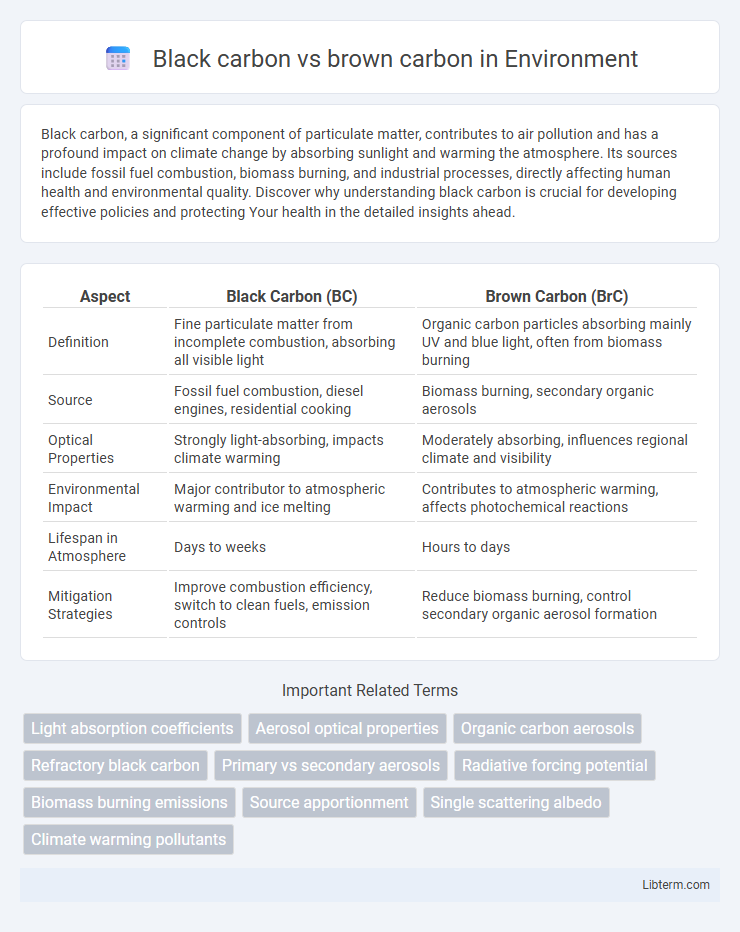Black carbon, a significant component of particulate matter, contributes to air pollution and has a profound impact on climate change by absorbing sunlight and warming the atmosphere. Its sources include fossil fuel combustion, biomass burning, and industrial processes, directly affecting human health and environmental quality. Discover why understanding black carbon is crucial for developing effective policies and protecting Your health in the detailed insights ahead.
Table of Comparison
| Aspect | Black Carbon (BC) | Brown Carbon (BrC) |
|---|---|---|
| Definition | Fine particulate matter from incomplete combustion, absorbing all visible light | Organic carbon particles absorbing mainly UV and blue light, often from biomass burning |
| Source | Fossil fuel combustion, diesel engines, residential cooking | Biomass burning, secondary organic aerosols |
| Optical Properties | Strongly light-absorbing, impacts climate warming | Moderately absorbing, influences regional climate and visibility |
| Environmental Impact | Major contributor to atmospheric warming and ice melting | Contributes to atmospheric warming, affects photochemical reactions |
| Lifespan in Atmosphere | Days to weeks | Hours to days |
| Mitigation Strategies | Improve combustion efficiency, switch to clean fuels, emission controls | Reduce biomass burning, control secondary organic aerosol formation |
Introduction to Black Carbon and Brown Carbon
Black carbon and brown carbon are significant components of atmospheric particulate matter, each influencing climate and air quality differently. Black carbon consists of pure carbon particles formed from incomplete combustion of fossil fuels and biomass, strongly absorbing sunlight and contributing to global warming. Brown carbon, primarily derived from organic compounds in biomass burning and secondary organic aerosols, absorbs light with a wavelength-dependent pattern, affecting atmospheric radiative forcing and visibility.
Sources of Black Carbon
Black carbon primarily originates from incomplete combustion of fossil fuels such as diesel engines, coal burning, and residential wood stoves, as well as wildfires and agricultural burning. Brown carbon, on the other hand, is mainly emitted from biomass burning and biogenic organic aerosols, contributing to light absorption in the atmosphere with distinct optical properties. Understanding these sources is critical for targeting air pollution reduction strategies and mitigating climate change impacts.
Formation of Brown Carbon
Brown carbon forms primarily from biomass burning and combustion processes involving organic matter, including wood, agricultural residues, and fossil fuels. Its formation involves complex photochemical reactions and oxidation of volatile organic compounds (VOCs) in the atmosphere, producing light-absorbing organic aerosols distinct from black carbon's soot particles. While black carbon is mostly elemental carbon from incomplete combustion, brown carbon consists of organic compounds that absorb light in the ultraviolet and visible spectrum, contributing differently to atmospheric warming and climate impacts.
Chemical Composition Differences
Black carbon primarily consists of elemental carbon arranged in graphitic structures, produced from incomplete combustion of fossil fuels and biomass. Brown carbon contains a complex mixture of organic compounds, including humic-like substances and light-absorbing organic molecules, which originate from biomass burning and secondary organic aerosol formation. The chemical composition differences influence their optical properties, with black carbon strongly absorbing across the visible spectrum while brown carbon absorbs more in the ultraviolet and visible blue wavelengths.
Optical Properties and Climate Impact
Black carbon exhibits strong light absorption across the visible spectrum, leading to significant atmospheric warming by absorbing solar radiation and reducing Earth's albedo. Brown carbon, primarily emitted from biomass burning, absorbs light mainly in the ultraviolet and short visible wavelengths, contributing to atmospheric heating but to a lesser extent than black carbon. Both aerosols influence climate forcing, with black carbon having a more pronounced effect due to its higher light absorption efficiency and longer atmospheric lifetime.
Role in Atmospheric Warming
Black carbon strongly absorbs sunlight and efficiently heats the atmosphere, significantly contributing to atmospheric warming and climate change. Brown carbon, while also absorbing light, primarily impacts shorter wavelengths and has a less pronounced heating effect compared to black carbon. Both types of carbon aerosols influence cloud formation and radiative forcing, but black carbon remains the dominant factor in atmospheric warming due to its higher absorption efficiency.
Regional Variations in Prevalence
Black carbon concentrations tend to be higher in urban and industrial regions due to extensive fossil fuel combustion, while brown carbon is more prevalent in areas affected by biomass burning and agricultural waste management. Regions in South Asia and Sub-Saharan Africa experience elevated brown carbon levels during seasonal crop residue burning, contrasting with the dominant black carbon emissions in North America and Europe from transportation and industrial activities. Satellite observations and ground measurements highlight these spatial differences, emphasizing the varied impact of socio-economic practices on carbonaceous aerosol distribution globally.
Environmental and Health Effects
Black carbon, a major component of particulate matter from incomplete combustion, significantly contributes to atmospheric warming by absorbing sunlight and accelerating ice melt in polar regions. Brown carbon, primarily emitted from biomass burning, impacts the environment by absorbing ultraviolet and visible light, altering atmospheric chemistry, and reducing air quality. Both black and brown carbon particles pose serious health risks, including respiratory and cardiovascular diseases, due to their ability to penetrate deep into the lungs and enter the bloodstream.
Mitigation and Control Strategies
Black carbon mitigation strategies emphasize reducing fossil fuel combustion through improved engine technologies, cleaner fuels, and enhanced emission standards, targeting transportation and industrial sectors. Brown carbon control focuses on limiting biomass burning and agricultural residue fires by promoting sustainable land management, alternative energy sources, and community awareness programs. Advanced monitoring systems and regulatory frameworks play a crucial role in tracking emissions and enforcing compliance for both black and brown carbon reduction.
Future Research Directions
Future research on black carbon (BC) and brown carbon (BrC) should emphasize advanced characterization techniques to distinguish their optical properties and chemical compositions under varying atmospheric conditions. Investigating the differential climate forcing effects and atmospheric lifetimes of BC and BrC through integrated modeling and field measurements will enhance predictive capabilities. Development of targeted mitigation strategies requires comprehensive studies on emission sources, atmospheric transformations, and deposition processes of both aerosols.
Black carbon Infographic

 libterm.com
libterm.com